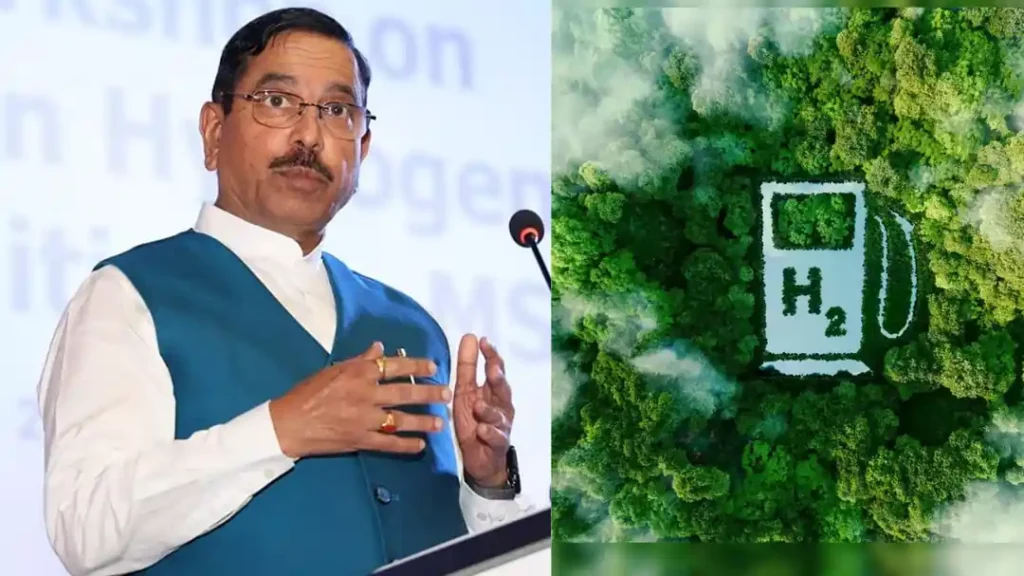New Delhi: In a landmark move to cement its position as a global leader in sustainable energy, the Indian government has rolled out the Green Hydrogen Certification Scheme of India (GHCI) under the ambit of the National Green Hydrogen Mission (NGHM). Spearheaded by the Ministry of New and Renewable Energy (MNRE) and with the Bureau of Energy Efficiency (BEE) as the nodal authority, the GHCI aims to establish a robust framework for certifying green hydrogen production, ensuring transparency, traceability, and market credibility. This initiative, launched on Tuesday, is a pivotal step toward achieving India’s ambitious target of producing 5 million metric tonnes (MMT) of green hydrogen annually by 2030.

What is the Green Hydrogen Certification Scheme of India (GHCI)?
The GHCI is India’s first-ever certification framework designed to verify that hydrogen is produced exclusively using renewable energy sources, thereby earning its designation as “green.” The scheme sets a comprehensive methodology for the measurement, monitoring, reporting, on-site verification, and certification of green hydrogen and its derivatives. By aligning with global standards, the GHCI ensures that India’s green hydrogen production is credible and competitive in international markets.
The certification process operates at the project level, encompassing all stages of green hydrogen production up to the compression and purification of hydrogen for transport. However, processes such as transportation, storage outside plant boundaries, conversion into hydrogen carriers, reconversion, and utilization are explicitly excluded from the certification scope. This focused approach ensures precision in assessing the environmental impact of green hydrogen production.
Key Features of the GHCI
The GHCI is packed with features that make it a game-changer for India’s renewable energy landscape:
- Scope: The certification applies to project-level green hydrogen production, covering processes up to purification but excluding downstream activities like transport and storage.
- Eligibility: The scheme currently supports hydrogen production through electrolysis and biomass conversion, with provisions for adding new pathways upon approval by the BEE.
- Monitoring: Producers are required to undergo annual third-party verification, with all data logged via the Green Hydrogen Portal for transparency.
- GHG Metric: Greenhouse gas (GHG) emissions are measured in kg CO₂ equivalent per kg H₂, following the MNRE Green Hydrogen Emission Calculation Methodology.
- Emission Threshold: To qualify as “green,” the average emission intensity must not exceed 2 kg CO₂ eq/kg H₂.
- Guarantee of Origin (GO): The scheme provides a Guarantee of Origin certificate to validate the legitimacy of green hydrogen claims.
- Certification Types: Two types of certificates are available:
- Concept Certificate: Voluntary, for projects in the planning or design phase.
- Facility-Level Certificate: Mandatory for operational green hydrogen production facilities.
- Non-Transferable: Certificates are non-transferable and non-tradable, and cannot be claimed for emission reduction credits.
- Compliance: The scheme is mandatory for all domestic green hydrogen producers but exempts units producing exclusively for export.
- Materiality Threshold: Emission sources contributing less than 1% of the total emission threshold are excluded from calculations, streamlining the certification process.
Operational Framework
The GHCI is supported by Accredited Carbon Verification (ACV) Agencies, which serve as the certification bodies. The evaluation cycle is set for each financial year, ensuring regular assessments of compliance. The scheme integrates seamlessly with India’s upcoming Carbon Credit Trading Scheme (CCTS), set to launch in 2026, enabling producers to leverage their green hydrogen production for carbon trading benefits.
Renewable energy for green hydrogen production can be sourced from a dedicated renewable energy project or transmitted through a common transmission line, offering flexibility to producers. The scheme’s operational guidelines are designed to accommodate diverse production setups while maintaining stringent environmental standards.
The National Green Hydrogen Mission (NGHM)
The GHCI is a critical component of the National Green Hydrogen Mission, launched in 2023 with the vision of transforming India into a global hub for the production, usage, and export of green hydrogen and its derivatives. The NGHM targets a production capacity of 5 MMT per annum by 2030, supported by strategic initiatives such as:
- Strategic Interventions for Green Hydrogen Transition (SIGHT) Programme: A flagship initiative to incentivize green hydrogen production and adoption.
- Green Hydrogen Hubs: Designated regions to foster large-scale production and innovation.
- Demand Creation: Strategies to boost domestic consumption and promote exports.
- Supply-Side Solutions: Addressing constraints in infrastructure and technology.
- Certification Framework: The GHCI itself, ensuring market credibility.
The NGHM’s holistic approach is designed to reduce India’s dependency on fossil fuels, attract investments, and position the country as a leader in the global green energy transition.
Significance of the GHCI
The launch of the GHCI holds profound implications for India’s energy sector and its global standing:
- Boosting Exports: By providing a credible certification framework, the GHCI enhances India’s competitiveness in the global hydrogen market. Notably, India recently signed agreements to supply 4.12 lakh tonnes of green hydrogen derivatives to Japan and Singapore, underscoring the scheme’s role in facilitating international trade.
- Attracting Investments: Clear market standards and traceability make India an attractive destination for investors in green hydrogen projects.
- Leadership in Green Energy: The GHCI reinforces India’s commitment to sustainable development and leadership in renewable energy innovation.
- Carbon Trading Integration: By aligning with the CCTS, the scheme enables producers to participate in carbon markets, creating additional revenue streams.
- Reducing Fossil Fuel Dependency: Green hydrogen, produced with zero or minimal emissions, is a key enabler for decarbonizing industries such as steel, cement, and transportation.
Industry Implications
The GHCI applies primarily to companies that have bid for government incentives under the NGHM, such as those participating in the SIGHT programme. However, it currently excludes exporters who have not availed of these incentives, creating a distinction between domestic and export-focused producers. This approach ensures that government-supported projects adhere to rigorous environmental standards while allowing flexibility for export-only units.
The 1% materiality threshold for emission sources simplifies the certification process by focusing on significant contributors to emissions, reducing administrative burdens for producers. This pragmatic approach balances environmental rigor with operational feasibility, making the GHCI accessible to a wide range of stakeholders.
Ministerial Perspective
Speaking at the launch event, Renewable Energy Minister Pralhad Joshi emphasized the scheme’s role in advancing India’s green energy agenda. “The Green Hydrogen Certification Scheme is a transformative step toward creating a transparent and credible framework for green hydrogen production. It will not only boost our domestic capabilities but also position India as a trusted supplier in the global market,” Joshi said.
The minister highlighted the scheme’s alignment with India’s broader climate goals, including its Nationally Determined Contributions (NDCs) under the Paris Agreement. By fostering innovation and accountability, the GHCI is poised to play a central role in India’s journey toward net-zero emissions.
Global Context
The launch of the GHCI comes at a time when green hydrogen is gaining traction worldwide as a versatile and sustainable energy carrier. Countries like Japan, Singapore, and the European Union are investing heavily in green hydrogen to decarbonize their economies. India’s proactive approach, exemplified by the GHCI, positions it as a key player in this emerging market.
The scheme’s emphasis on traceability and low-emission production aligns with international standards, such as those set by the International Renewable Energy Agency (IRENA) and the European Union’s CertifHy scheme. This compatibility enhances India’s ability to meet the stringent requirements of global buyers, paving the way for long-term export agreements.
Future Outlook
As India ramps up its green hydrogen production, the GHCI will serve as a cornerstone for building a credible and scalable ecosystem. The scheme’s integration with the Green Hydrogen Portal ensures real-time data tracking, while annual third-party verifications maintain accountability. Over time, the BEE may expand the certification scope to include additional production pathways, further broadening the scheme’s impact.
The GHCI also sets the stage for India to lead the development of global green hydrogen standards, fostering collaboration with international organizations and governments. By establishing itself as a pioneer in green hydrogen certification, India is well-positioned to shape the future of the global hydrogen economy.
Conclusion
The Green Hydrogen Certification Scheme of India (GHCI) is a bold and forward-thinking initiative that underscores India’s commitment to sustainability and innovation. By ensuring transparency, traceability, and credibility in green hydrogen production, the scheme paves the way for India to achieve its 5 MMT production target by 2030 and emerge as a global leader in the green energy transition. With robust support from the National Green Hydrogen Mission and strategic partnerships with countries like Japan and Singapore, India is poised to redefine the future of clean energy.
Frequently Asked Questions (FAQs)
1. What is the purpose of the Green Hydrogen Certification Scheme of India (GHCI)?
The GHCI, launched by the Ministry of New and Renewable Energy (MNRE) under the National Green Hydrogen Mission (NGHM), aims to certify hydrogen produced using renewable energy as “green.” It establishes a framework for measuring, monitoring, reporting, verifying, and certifying green hydrogen production to ensure transparency, traceability, and market credibility. The scheme supports India’s goal of producing 5 million metric tonnes (MMT) of green hydrogen annually by 2030, with the Bureau of Energy Efficiency (BEE) as the nodal authority.
2. What processes are covered under the GHCI certification scope?
The GHCI certifies green hydrogen production at the project level, covering all stages up to the compression and purification of hydrogen for transport. It excludes processes like transportation, storage outside plant boundaries, conversion into hydrogen carriers, reconversion, and utilization. The certification ensures that greenhouse gas (GHG) emissions do not exceed 2 kg CO₂ eq/kg H₂, following the MNRE’s Green Hydrogen Emission Calculation Methodology.
3. Who is eligible for GHCI certification, and what types of certificates are issued?
The GHCI applies to green hydrogen production via electrolysis and biomass conversion, with the possibility of adding new pathways upon BEE approval. It is mandatory for domestic producers, especially those availing government incentives under the NGHM, but exempts export-only units not using incentives. Two types of certificates are issued: a voluntary concept certificate for projects in the planning phase and a mandatory facility-level certificate for operational production facilities. Certificates are non-transferable and non-tradable.
4. How does the GHCI ensure compliance and transparency?
Compliance is enforced through annual third-party verification by Accredited Carbon Verification (ACV) Agencies, with data logged on the Green Hydrogen Portal. The scheme uses a Guarantee of Origin (GO) to validate green hydrogen claims and sets a 1% materiality threshold for emission sources to streamline assessments. These measures ensure transparency and align with India’s upcoming Carbon Credit Trading Scheme (2026) for carbon market integration.
5. How does the GHCI contribute to India’s global and environmental goals?
The GHCI enhances India’s global hydrogen market credibility by ensuring low-emission, traceable production, supporting export agreements like the supply of 4.12 lakh tonnes of green hydrogen derivatives to Japan and Singapore. It attracts investments by setting clear market standards, reduces fossil fuel dependency, and supports decarbonization of industries. By aligning with the NGHM’s 5 MMT target by 2030 and India’s Paris Agreement commitments, the GHCI positions India as a leader in the global green energy transition.

